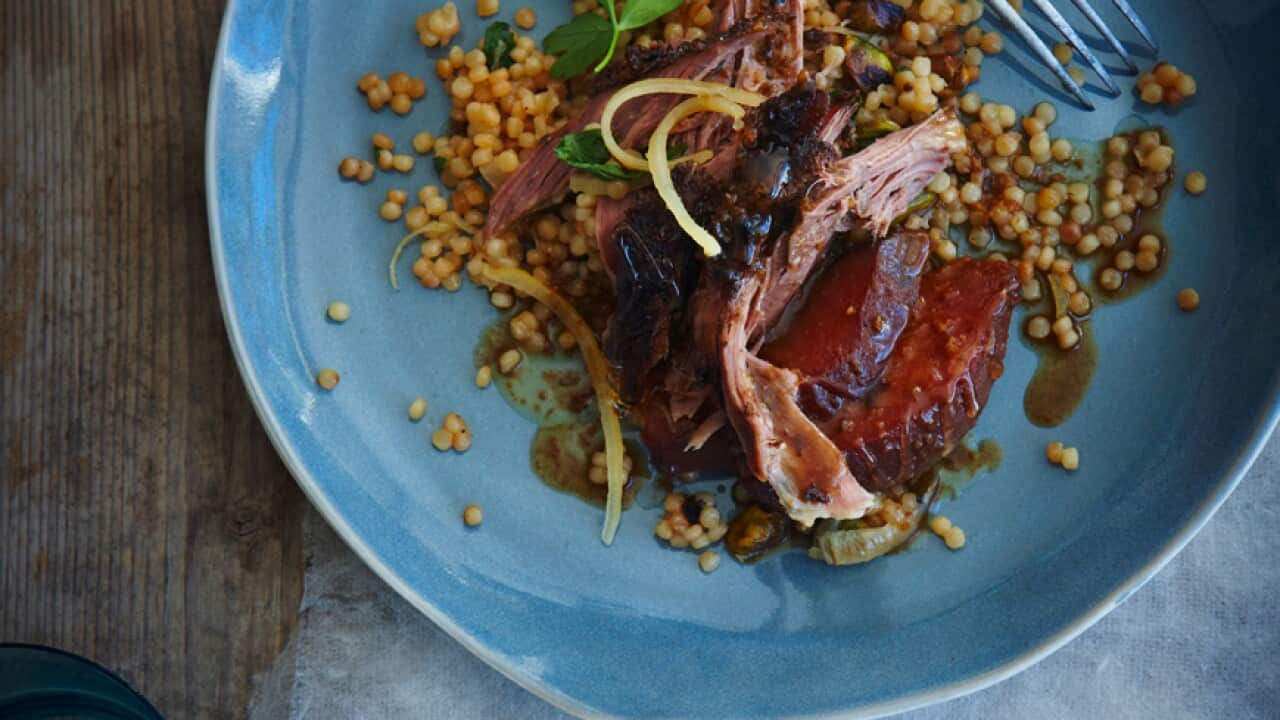In many parts of the world in Medieval times, diners had a fine excuse for enjoying one of their favourite sweet treats: they believed eating a sugary morsel at the end of the meal would aid digestion. Alongside candied nuts and seeds and sweet wines, .
And among them was something that reflects an amazing transformation.
Think of the quince - a hard, bumpy yellow fruit. And then think of a rich, red, sweet toffied treat, a frangrant mouthful.
In the winter episode of (8.35pm Thursday 2 February on SBS), Raymond Blanc and Kate Humble are in raptures over the possiblities of the quince.
Kate joins food historian Ruth Goodman in the old kitchens of Kew Palace, as Goodman prepares a favourite dish of the Medieval Royal household: quince jellied sweets.
Quinces, Ruth explains, "are where all jam started". Quinces are high in pectin - a natural setting agent - and Ruth theorises that the quince is "the mother of jams". "This is the first fruit than someone somewhere in Persia discovered would do that thing [set] when you combine it with sugar."
And for the royals of Medieval England, quince jellies and other sweets were treated a bit like the modern after-dinner mint.
"The whole idea of how digestion worked at the time was that your stomach resembled a cauldron with a fire in your belly at the base," Ruth explains. "And as the food went in it was cooked within your stomach to break it down further before it was then moved on to the next stage of digestion. So if you took something like a little quince sweet and put it in first the fire would be too hot and it would catch and burn... So the first thing you want to eat is something good and hearty and soup-like. Then the heavier meat on top as they are going to need good high heat to cook them. And then you close your stomach at the top with a little sugary quince."
Ruth makes a tray of candied quince as it was done centuries ago, stewing the quince in a jug over a flame to break down the fibrous fruit and release pectin, then pounding sugar in a mortar and pestle - until the twentieth century, sugar came in the form of solid cones - before adding it to the strained quince and cooking it further, stirring constantly. Eventually, it's turned out and cut - forming something that's like a soft toffee. It's a method found in multiple Medieval and Renaissance-era recipes, such as the Jelly of Quinces in Nieuwe Vaderlandsche Kookkunst from 1797 (find a modern interpretation ) or the Elizabethan Quince Paste recipe , based on several old cookery books. For a modern take, try our recipe for Quince candies - great for a cheese platter or to give as gifts:
It's a method found in multiple Medieval and Renaissance-era recipes, such as the Jelly of Quinces in Nieuwe Vaderlandsche Kookkunst from 1797 (find a modern interpretation ) or the Elizabethan Quince Paste recipe , based on several old cookery books. For a modern take, try our recipe for Quince candies - great for a cheese platter or to give as gifts:

Ruth Goodman's quince jellied sweets: "a regal shine" says Kate Humble. Source: Royal Gardens on a Plate
sweet treats

Quince candies
Kate's verdict on the royal quince candy? "What a fitting end to the world’s most voluptuous fruit. That’s delicious!" It's the long slow cooking of both the added sugar and the sugar in the fruit that creates the final rich red colour, so different from the pale flesh of the raw fruit. Chef Raymond Blanc is also cooking with quince, serving up and .
Chef Raymond Blanc is also cooking with quince, serving up and .

Source: Royal Gardens on a Plate
And where some might see the lumpy quince as an ugly fruit, Raymond finds it a delight.
"This fruit, I love them so much because I find them structurally so beautiful. It’s very masculine. And you can see the muscle ripple around this quince. Heavy as well. With that flesh – yellow with a tinge of green with a shade of the finest hair on it. I find it beautiful. And it’s all masculine on the outside – and when you cut it in half it’s completely feminine." Long cooking is the secret to transforming that muscular fruit into melting mouthfuls, such as Raymond's .
Long cooking is the secret to transforming that muscular fruit into melting mouthfuls, such as Raymond's .

Source: Royal Gardens on a Plate
And for those who'd rather eat quince candies before your main meal rather than after - good news. Ayurvedic dietary theory .





